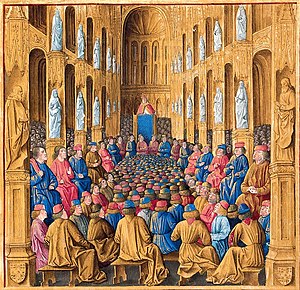Creeperian Crusade
| Creeperian Crusade | |||||||
|---|---|---|---|---|---|---|---|
| Part of the Creeperian-Deltinian Wars and the Creeperian Wars of Religion | |||||||
 Taking of Almadinat Almuqadasa by the Crusaders | |||||||
| |||||||
| Belligerents | |||||||
| |||||||
| Commanders and leaders | |||||||
|
|
| ||||||
| Strength | |||||||
|
Creeperans: ~3,500,000 Castillianans: ~1,300,000 Papacy: 100,000 |
Deltinians: ~4,000,000 Abdaners: 300,000-500,000 Helamans: 250,000-300,000 Jakizians: 250,000-300,000 | ||||||
| Casualties and losses | |||||||
|
Creeperans: High Castillianans: Moderate Papacy: Low |
Deltinians: High Abdaners: Moderate Helamans: Moderate Jakizians: Very High | ||||||
The Creeperian Crusade (Creeperian Spanish: Cruzada Creeperiano, Arabic: الحملة الصليبية الزاحفة, transliterated as alhamlat alsalibiat alzzahifa) was a series of various military campaigns and religious wars initiated by the ethnic Creeperans of the Emirate of Rabadsun against the Caliphate of Deltino. The initial objective of the crusade was to secure the independence of the Kingdom of Creeperopolis and recapture all territory claimed to he "historic Creeperian land" that was controlled by the Old Kingdom of Creeperopolis (537AD–745AD) and the Creeperian Confederation (220BC–537AD).
The crusade began on 8 February 1231 when Alfawnasu III, the then-reigning Emir of the Emirate of Rabadsun, declared independence for the ethnic Creeperans living there. He proclaimed himself King of the Creeperans of the Kingdom of Creeperopolis. The declaration was made in response to the One-Religion Decree established by Suleiman III, the Caliph of the Caliphate of Deltino, on 31 January 1231. The decree outlawed the practicing of any religion that was not Deltinian Islam, effectively creating a theocracy with no religious freedom. The decree, therefore, outlawed the practicing of Creeperian Catholicism, the religion of the Creeperian people. The Creeperans had until 9 February to renounce their faith. Alfawnasu III, with the approval of Pope Jiryjuriun IX, decalred independence and called for a crusade against the Deltinian Muslims to secure freedom for the Creeperans.
Instead of reverting to the Old Creeperian language, the Creeperans adopted the Spanish language and de-Arabized their kingdom. Rabadsun was renamed to Creeperopólis, meaning "City of the Creeperans." Alfawnasu III changed his name to Alfonso I and Jiryjuriun IX changed his name to Gregorio IX, with all Creeperans following suit and solidifying the Creeperian naming customs. Suleiman III did not accept the declaration and war began. Instead of one war, the crusade was a series of wars fought between Creeperopolis and Deltino. The crusade came to an end under the reign of Miguel I. His reign witnessed both the collapse of the Caliphate in 1326 and the fall of Deltino's three rump successor states: the Emirates of Abdan, Helam, and Jakiz, in 1345.
The crusade occurred across the Southern Landmass for a period of 115 years between the establishment of Creeperopolis in 1231 and the fall of the Shata' Albahr in 1345. The collapse of Deltino and its successor rump states allowed Creeperopolis to become the dominant nation on the landmass. The crusade marked the end of Islamic dominance on the landmass and began the ongoing period of Catholic dominance. The crusade is often used in Creeperopolis to promote Islamophobia and anti-Deltinian sentiment.
Contents
Background
Early Creeperian-Deltinian relations
| Part of a series on |
| Islam |
|---|
 |
|
|
| Part of a series on |
| Creeperian Catholicism |
|---|
 |
The Old Kingdom of Creeperopolis was established in 537AD by Felipe I of the Amacha Tribe, later the House of Amara, following victory in the War of Creeperian Unification that ended the Creeperian Confederation (220BC–537AD). The Creeperans were pagans until 540AD when Vigilio I, the Pope of the Catholic Church, arrived in Creeperopolis and converted the population to Catholicism. The Church subsequently became known as the Creeperian Catholic Church due to its heavy association with Creeperopolis. As a result of the conversion of the Creeperian population, many sites associated with the old Creeperian Pagan gods were destroyed by Felipe I as a part of the Bull of Yerkink that mandated such. Thousands were killed for refusing to convert.
For over 200 years, the Creeperans existed on the Southern Landmass without very much contact with the outside world. However, in 734AD, the Kharzamite of Deltino was forced to flee from Ecros to the Southern Landmass as a result of their defeat in the Deltinian Wars of the Nihil. The Deltinians under Selim I, the Caliph of the Deltinians, established the Caliphate of Deltino north of Creeperopolis. The Creeperans and Deltinians first came into contact in 744AD which resulted in a Deltinian invastion of Creeperopolis. Under Caliph Adbul I, the Deltinians conquered the Creeperian kingdom under King Fidel II in 745AD. The Deltinians established the Emirate of Rabadsun as a client state ruled through Rudulifu I, the younger brother of Fidel II.
Deltinian rule through Rabadsun
The Deltinians ruled Rabadsun through the House of Amara through the lineage of Rudulifu I. In 1120, Rabadsun came under the rule of Emiress for the first time after the death of Filibi II and Khusih. Emiress Mariaan I was heavily opposed by the Deltinian Caliph, Abbas I. Abbas I sought to depose Mariaan I and so he gave her an ultimatum: marry and renounce her claim to the throne or be forcibly deposed. She relented and married Alfawnasu Rudulifu Martiniz Santus, a Rabadsuni nobleman. He ascended to the throne and became Alfawnasu I, establishing the House of Martínez.
Alfawnasu I was succeeded by his son, Alfawnasu II, and his son, Rudulifu IV. Alfawnasu III became Emir following the death of Rudulifu IV on 8 March 1230. Then, on 13 January 1231, Caliph Suleiman II died and was succeeded by his son, Suleiman III. On 31 January 1231, Suleiman III sought to unite his entire domain under Deltinian Islam and proclaimed the One-Religion Decree. The decree outlawed the practicing of any religion that was not Deltinian Islam, effectively creating a theocracy with no religious freedom. The decree, therefore, outlawed the practicing of Creeperian Catholicism, the religion of the Creeperian people. Suleiman III gave the Creeperans until 9 February to renounce their faith or face serious repercussions for defying the order of the Caliph.
Suleiman III cited the reasoning for the decree was that he had a dream where Muhammad instructed him that bringing the Creeperans to convert to Islam would please Allah and that He would reward him greatly. Islamic scholars have since contested Suleiman III's claim, with some scholars believing that the entire story was a fabrication, while others believe that the story had some creedance to it but that Muhammad wished for a peaceful conversion, instead of the violent war that would emerge as a result of the decree.
Progression of war
Catholic revolt

Alfawnasu III was deeply concerned about his position as Emir since he did not wish to convert, as did the Pope, Jiryjuriun IX, who would have his position entirely abolished. Suleiman III informed Jiryjuriun IX that he could be instated as the chief religious official of Rabadsun as compensation for his loss of position, but he did not wish to convert either.
Jiryjuriun IX convened the Council of Rabadsun, a meeting of the Creeperian Catholic Church's top officials, wealthy nobles, and royalty. The One Religion Decree and the Church's reaction to it was the top priority of the council. The council was spoken in Old Creeperian as to not allow the Deltinians to understand what they were saying since the Deltinians spoke only Arabic and Deltinian Spanish. The Creeperans did not risk speaking in Creeperian Spanish since there were still many similarities with Deltinian Spanish. The council convened from 4 to 7 February 1231. Church and government officials came to an agreement: the Creeperans will not convert and the Creeperans will fight to continue worshipping God how they want to. Alfawnasu III informed every one of his army officials that a rebellion was necessary, and his officials informed the soldiers. The soldiers and officers unanimously sided with the Emir and the Pope and the uprising was set for 8 February.
On 8 February 1231, Jiryjuriun IX announced to the people of Rabadsun that the Creeperans will not submit to the One Religion Decree and will revolt to worship God how the Creeperans have always worshipped God. He declared that Rabadsun would de-Arabize and he changed his name to Gregorio IX. The common people spoke Creeperian Spanish but their names followed Arabic customs. The De-Arabization was the process of renaming all Arabic names to Creeperian Spanish names which established the Creeperian naming customs. Alfawnasu III declared himself Alfonso I and proclaimed the independence of the Kingdom of Creeperopolis, meaning "city of the Creeperans," taking the name of the Old Kingdom of Creeperopolis and officially abandoning the name Rabadsun.
The Creeperian Army and Creeperian Navy were established from the Rabadsuni Army and Rabadsuni Navy. The Army, numbering 30,000 men, successfully revolted and defeated the local Deltinian Army garrison of 2,000 men. The Creeperian victory began the Creeperian War of Independence and the first phase of the Creeperian Crusade. Alfonso I decreed the changing of the name of the city, Rabadsun, to Salvador (Creeperian Spanish for "Savior"), in reference to Jesús, the Savior of the world.
Aftermath
| Part of a series on |
| Abrahamic religions in Terraconserva |
|---|
 |
Atrocities
Wars
- Creeperian War of Independence, 8 February 1231 – 19 October 1232, Creeperian victory





